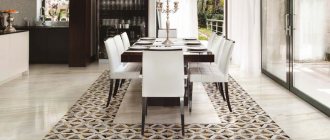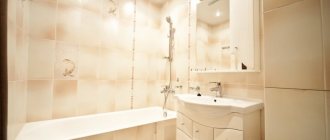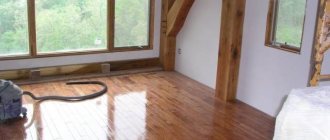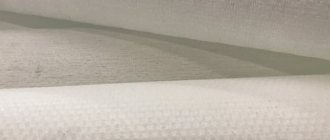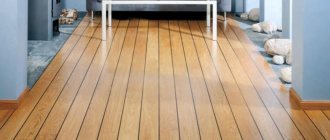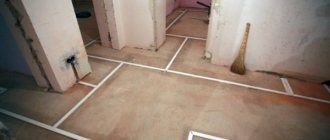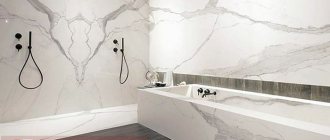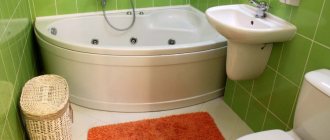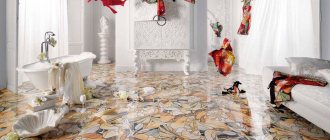When choosing materials for finishing a bathroom, you can get confused by the large selection of different solutions. Most often, tiles are used for the bathroom, but they also have many varieties. One of them is called “hog”. Boar tiles in the bathroom are an excellent solution. In this article you can find out what it is, how to choose this type of tile and what kind of interior it is suitable for.
“Boar” tiles are considered universal and are suitable for decorating bathrooms in various styles.
What is a hog tile?
Previously, “hog” tiles were used for façade cladding. The tiles were used to depict the Art Nouveau style that was popular two centuries ago. Nowadays, it is used to complement the interior and beautifully combine with other styles and as separate designs in the room.
They gave it an interesting name because during the production of the tiles, both sides were covered with gloss or glaze, and on the sides there were two through holes that looked like a nickel of a pig or wild boar.
This building was needed for ease of transportation. Afterwards, the builders used a pick to split the material, leaving two separate tiles that could be conveniently laid out.
How to properly prepare the surface
Before installation, you should carefully inspect the walls for any unnecessary remnants of plaster or old paint. They must be cleaned to avoid peeling when exposed to adhesive under the tiles. The walls must be puttied and primed.
Possessing significant weight and a fairly large thickness, the tiles require application of an adhesive composition to the wall surface along with its application to the tile base.
Only in this case is the required adhesion coefficient and, as a consequence, long service life achieved.
Color palette of tiles "hog"
The tiles have a wide range of colors, from warm shades to bright ones, we list the main ones:
White
Pairs well with other colors such as blue, black, red and other interesting colors. The white shade itself is considered a universal color that can act as an independent color scheme in a room.
But for variety, black is added to highlight interior details or add originality. Black and white looks very impressive.
Red
This color is best used with a combination of other colors, as red can cause irritability and aggressiveness. The shade is rarely used as an independent color. Imagine that it completely covers your bathtub, and your eyes immediately begin to hurt. White is considered the best combination with red.
Green
Can be the main color. The shade evokes calm and tranquility. Green can be combined with white, or with shades of warm.
There is a wide variety of green color in the tiles. Both very bright and very warm colors.
Yellow
Rarely used as one color in a room. It is better to use in small quantities because the shade is very bright in color. But if you still like yellow, it is better to dilute it with white or green shades.
Black
The color is created for lovers of glamor and black. The shade is usually used in large rooms to emphasize the structure of the room. Black is combined with white, gray, and other neutral colors. For big fans, black can be used as the main color.
Blue
Blue is mainly used to decorate the bathroom. It has a shade that is pleasing to the eyes. Causes a feeling of freshness and lightness. Blue is combined with white, gray, black. But it is often used as the main color.
Tile texture
There are two textures of “hog” tiles, a small choice, it seems at first glance, but in fact, the choice is complex and varied:
- Glossy. Glossy tiles always look good in the bathroom. That's why they are often used in interiors.
- Matte. Matte tiles are rarely used, even in simple interiors. All because of the dissimilarity with other materials.
Standard laying algorithm
Installation of the cladding is carried out in the traditional way.
Tools needed:
- Toothed (comb) and rubber spatulas.
- Bubble level.
- Painting cord.
Materials:
- Tile adhesive.
- Grout.
- Plastic crosses.
Preparatory stage
To lay tiles you need a flat and solid base.
For this wall:
- They are freed from old finishing and peeling plaster, which makes a booming sound when tapped.
- Level with cement-sand mortar.
- Treat with a deep penetration primer. The composition increases adhesion and strengthens the surface layer of the base. In the bathroom it is recommended to use a primer with an antiseptic.
Due to its heavy weight, the “hog” is not placed on tiles or paint. But if removing the old finish is impossible, you should resort to surface reinforcement.
Procedure:
- Holes are drilled in the wall using a square nest method in increments of 20-25 cm.
- They hammer dowel nails into them.
- Attach wire to hardware.
In this case, the tiles are laid on quick-drying glue.
The process of laying boar tiles with glue.
Surface marking
Marking is done in this order:
- Using a spirit level, determine the highest angle of the floor.
- From it on the wall measure a distance equal to the thickness of the floor covering + the height of the tiles + the width of the seam.
- A strictly horizontal line is drawn through this point, controlling its position according to the spirit level.
- Using a plumb line, draw verticals in increments equal to the width of the modules.
For diagonal laying, markings are made at an angle.
Laying and grouting
The work is carried out in the following sequence:
- A temporary starting profile is screwed under the bottom horizontal line to keep the tile from sliding.
- Prepare the glue.
- Apply the mixture to a small area of the wall above the profile and level it with a notched trowel.
- Take the tile and apply glue to its back side. This is done due to the heavy weight of the material. Compact modules are covered with a thin layer, removing almost all the glue with a spatula. On large specimens, the composition is leveled with a comb.
- Glue the tile to the wall so that its bottom edge rests on the starting profile, and level it using a bubble level.
- Continue the bottom row, placing crosses between the modules. Using the rule, it is ensured that the front edges of all the “hogs” lie in the same plane.
- Every 2-3 rows make a pause so that the material does not slip under its own weight.
- Having completed the wall cladding, remove the starting profile and lay the bottom row.
https://youtube.com/watch?v=rmlkXc7BfKQ
After a day, the seams are cleaned of glue with a knife and filled with grout using a rubber spatula. In the bathroom, it is recommended to use an epoxy-based composition that is highly moisture resistant. Due to its high setting speed, it is washed off the tiles immediately; other types - after 15-30 minutes.
Hog tile size
The tiles vary in size:
- 10Х20
- 5Х15
- 10X10
- 10Х30
- 7Х15
- 90Х60
- 75Х150
- 60X30
- 10X10
- 200Х100
- 15Х40
Advantages and disadvantages of hog tiles
Pros:
- Durability
- Great chemical exposure
- Moisture resistance
- Variety of tile sizes.
- The tiles are not harmful to health because there are no dangerous chemical compounds
- Variety of tile designs (texture and color palette)
Minuses:
- Fragility
- Gives off cold (the material is ceramic)
- Weight. (The tiles are heavy for future construction. The base must be carefully prepared)
- Difficult installation (many seams due to size)
Necessary Requirements
Materials for finishing a bathroom must be selected especially carefully, as they must meet certain requirements. Otherwise, there is a risk that the service life will be very short. Let's consider the necessary requirements.
- Moisture resistant. The tiles should not absorb moisture, and there is a lot of moisture in the bathroom space. If the material absorbs moisture, then with high humidity it will very quickly fail, mold and mildew will appear, and the appearance will also change for the worse. Among other things, the tile may simply fall off due to the fact that it becomes heavy. To determine the level of moisture resistance, you need to look at the back of the tile: there should be almost no pores on it.
- Resistant to cleaning. When cleaning a bathroom, aggressive or chemical cleaning agents are almost always used. They will get on both the tile and the seams at the junction. Tiles that are not resistant to such substances will quickly lose their appearance.
- Evenness on all sides. To check this, you can look at a stack of stacked tiles: if the distance differs by even a millimeter, this is a bad indicator. Laying such tiles will be problematic, the seams will be uneven.
- No damage. There should be no chips or cracks, the pattern should be distributed evenly. If the pattern on one tile is different in color or size, it is most likely a defect. It is better not to purchase such material. It is also important to pay attention to the fact that there are no irregularities, and that the color is of high quality and deep.
Tiles produced in modern times can have different textures - smooth, matte, aged or mirrored.
Competent selection of colors of ceramic tiles allows you to get an original interior
Bathroom interior
Loft. Bricks are used in the loft interior. The “hog” tile can replace real bricks and will not differ in any way.
The style emphasizes rough shapes. It includes warm colors like brown. Wood is used to highlight accents in the bathroom.
Art Deco
This design is for those who love luxury. A style appeared from Western Europe and America. Art Deco is still gaining popularity among people and designers. The interior looks luxurious and is always suitable for a bathroom.
Minimalism
This style requires white hog tile. This interior is famous for the fact that it includes a minimum of accessories, objects and furniture. There is an alternative to minimalism, but it’s quite cheap, but if we talk about minimalism as a style, it turns out to be quite expensive.
Modern style
The style is reminiscent of minimalism, but you can add more than a minimum number of things to the room. The interior features light colors and simple bathroom furnishings.
The design of a room can use wood to highlight details and accents in the room.
Finishing in English style
Speaking about the design of a bathroom with hog tiles, in a style corresponding to the traditions of English culture, it is implied that the decoration includes:
- elements of aristocracy;
- symmetry;
- laconism;
- proportionality and clear forms.
When using this style, you should take the selection of the color palette more seriously, avoiding using saturated and “flashy” color solutions.
Preference usually leans towards a complex range of shades, associated with the colors “tea rose”, “ivory”, light blue and brown tones. Along with a light range of colors, dark colors are welcome.
Laying tiles “hog”
There are basic types of layout, which will be discussed below. One layout can be combined with another layout. All for your consideration:
- Horizontal stack - is an average level of layout complexity. From the outside it looks quite simple, except for the fact that you need to lay the tiles perfectly, seam to seam. This requires sharpened hands that can do the job quite perfectly.
- Vertical stack - similar to horizontal stack, but the display is vertical, which greatly complicates this work. In order not to make the work dirty and of poor quality, it is better to hire specialists. This stack is one of the most difficult to lay out.
- Herringbone is a popular and classic layout. There is practically nothing to say about this layout, only that it has its own characteristics. That is, you need to lay it out quite evenly in order to get exactly the “Christmas tree”, and not a crooked resemblance to the shape of a Christmas tree.
- Checkerboard - using the “hog” tile, you can lay out a chessboard, but it will take much longer. The chess board can alternate in colors (checkerboard) or alternate first horizontally, then vertically. It looks very impressive.
- Diagonal is one of the most difficult layouts. You definitely need to call a specialist for such a calculation. If you do not have such layout experience, you don’t have to try. The diagonal should go straight, but not in waves. For beginners, it turns out in waves and we advise you to call a specialist. The work is difficult and requires patience
